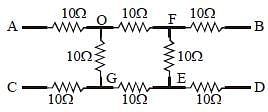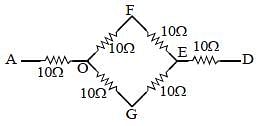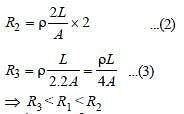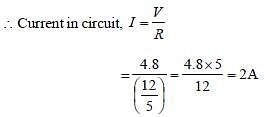31 Years NEET Previous Year Questions: Current Electricity - 3 - NEET MCQ
30 Questions MCQ Test Physics Class 12 - 31 Years NEET Previous Year Questions: Current Electricity - 3
The masses of the three wires of copper are inthe ratio of 1 : 3 : 5 and their lengths are in theratio of 5 : 3 : 1. The ratio of their electricalresistance is [1988]
Two batteries of emf 4 V and 8V with internal resistance 1 Ω and 2 Ω are connected in a circuit with a resistance of 9 Ω as shown in figure. The current and potential difference between the points P and Q are [1988]
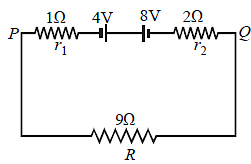

| 1 Crore+ students have signed up on EduRev. Have you? Download the App |
n equal resistors are first connected in seriesand then connected in parallel. What is the ratioof the maximum to the minimum resistance ?[1989]
Forty electric bulbs are connected in series across a 220 V supply. After one bulb is fused the remaining 39 are connected again in series across the same supply. The illumination will be [1989]
A current of 2 A, passing through a conductorproduces 80 J of heat in 10 seconds. Theresistance of the conductor in ohm is [1989]
Two identical batteries each of e.m.f 2V andinternal resistance 1Ω are available to produceheat in an external resistance by passing a currentthrough it. The maximum power that can bedeveloped across R using these batteries is  [1990]
[1990]
You are given several identical resistances eachof value R = 10Ω and each capable of carrying amaximum current of one ampere. It is required tomake a suitable combination of these resistancesof 5Ω which can carry a current of 4 ampere. Theminimum number of resistances of the type Rthat will be required for this job is [1990]
In the network shown in the Fig, each resistance is 1Ω. The effective resistance between A and B is [1990]

Faraday’s laws are consequence of conservationof [1991]
The velocity of charge carriers of current (about1 amp) in a metal under normal conditions is ofthe order of [1991]
Direct current is passed through a coppersulphate solution using platinum electrodes. Theelements liberated at the electrodes are [1993]
Three resistances each of 4 Ω are connected toform a triangle. The resistance between any twoterminals is [1993]
Current through 3 Ω resistor is

0.8 amp., then potential drop through 4Ω resistor is [1993]
A 4 μF capacitor is charged to 400 volts andthen its plates are joined through a resistance of1k Ω. The heat produced in the resistance is [1994]
In the circuit shown in Fig, the current in 4 Ω resistance is 1.2 A. What is the potential difference between B and C. [1994]

A heating coil is labelled 100 W, 220 V. The coil iscut in half and the two pieces are joined in parallelto the same source. The energy now liberatedper second is [1995]
If a wire of resistance R is melted and recasted tohalf of its length, then the new resistance of thewire will be [1995]
Two wires of the same metal have same length,but their cross-sections are in the ratio 3:1. Theyare joined in series. The resistance of thickerwire is 10Ω. The total resistance of thecombination will be [1995]
If the resistance of a conductor is 5 Ω at 50ºCand 7Ω at 100ºC, then the mean temperature coefficient of resistance (of the material) is[1996]
What will be the equivalent resistance of circuitshown in figure between two points A and D [1996]
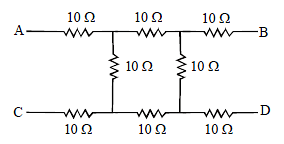
If a negligibly small current is passed through awire of length 15 m and of resistance 5Ω havinguniform cross-section of 6 × 10–7 m2 , thencoefficient of resistivity of material, is [1996]
Kirchoff’s first law, i.e. ∑i = 0 at a junction, dealswith the conservation of [1992, 1997]
A (100 W, 200 V) bulb is connected to a 160Vpower supply. The power consumption would be [1997]
There are three copper wires of length and cross sectional area  . Inwhich case is the resistance minimum? [1997]
. Inwhich case is the resistance minimum? [1997]
The current in the following circuit is [1997]

Three equal resistors connected across a sourceof e.m.f. together dissipate 10 watt of power.What will be the power dissipated in watts if thesame resistors are connected in parallel acrossthe same source of e.m.f.? [1998]
If nearly 105 coulombs liberate 1 gm-equivalentof aluminium, then the amount of aluminium(equivalent weight 9), deposited throughelectrolysis in 20 minutes by a current of 50 amp.will be [1998]
A 5ºC rise in temperature is observed in aconductor by passing a current. When thecurrent is doubled the rise in temperature will beapproximately [1998]
The resistance of a discharge tube is [1999]
The current (I) in the given circuit is [1999]

|
98 videos|387 docs|104 tests
|











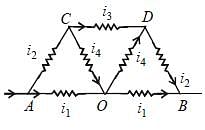














 (if is constant)
(if is constant)
